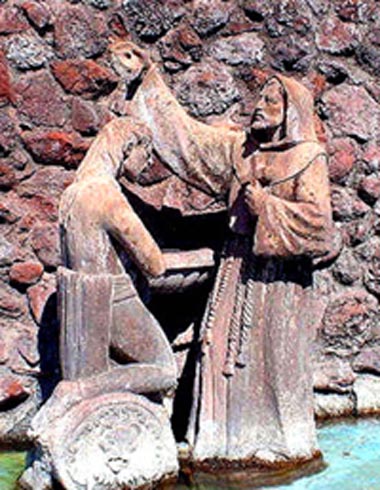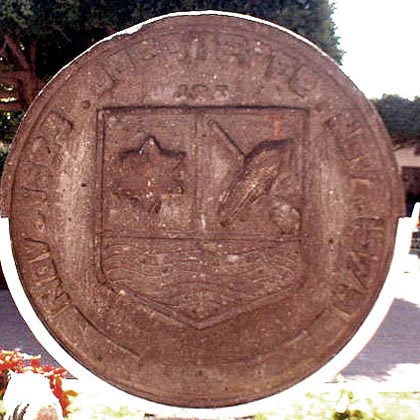Considering we were relative newcomers, it was a surprise and an honor in 1979 when we were asked to join the planning committee for the 450th anniversary of the founding of our village of Jocotepec.
I couldn’t resist saying to my husband, Georg, “I presume 450 years ago is when the Spaniards found it. The native Americans who’d lived in the area for thousands of years probably didn’t know the village was missing.”
Nonetheless, we were pleased to be included in this major village celebration. The first meeting was held in one of the oldest buildings in town, La Quinta. Local historians claimed that the ancient hotel was so named because it had been the fifth stop along the way for stagecoaches and other 19th century vehicles traveling from Mexico City to Guadalajara.

At the beginning of the meeting, someone suggested passing a hat and the thirty or so persons attending deposited twenty pesos each for “general expenses.” Those in charge, the mayor and others, outlined all the wonderful plans for the festivities that were take place a few months later in November.
At the end of the meeting it was decided that the money collection hadn’t been necessary after all, so the sombrero went around the long table once again and each of us retrieved our twenty pesos. Mysteriously, though no one had left the room, there were still twenty pesos left in the hat.
Our friend, John, the only other foreigner on the committee finally raised a finger and admitted, red-faced, that he had donated an extra twenty to the cause. We would come to learn that this sort of thing was quite typical for our not wealthy but always generous friend.
A few days later, a city official turned up at our house in a state of nervous excitement. He told us, “We’ve searched and searched. It doesn’t seem possible, but we can’t find the city crest. There has to have been a shield, an emblem once upon a time, but it’s vanished. We really must have a crest for all the printed materials: the stationery, the posters. Since you are an artist, can’t you please design one for us?”
“By when do you need it,” Georg asked.
“Well, the sooner the better, actually,” the official answered. Could you have it by the day after tomorrow?”
Although, Georg had never designed a city crest before, being a European he was used to a certain amount of pomp and ceremony. How hard could this be?
Well, he thought, I know the general shape of a coat of arms. I’ll divide it into three fields. Now what is Jocotepec famous for? Or at least well known. Fishing and agriculture are the main sources of income. What if I place an ear of corn diagonally crossing a boat paddle in one of the two upper fields?
Now what about the wide, horizontal space below? Jocotepec is the last village at the west end of Lake Chapala. Wouldn’t some waves, symbolizing the economic, historic, and aesthetic importance of water and the lake be perfect in that spot? Georg thought?
The crest was definitely shaping up nicely. But there was still one field remaining at the left top side of the crest. No immediate, clever idea seemed to be popping up in his imagination.
We tried brainstorming the problem, tossing out words just to see how they sounded. “Pearl of the west? .No, that would be rather difficult to draw. Star of Jalisco? Hmmm. Yes, a star is always good, and it could stand for various things.

Georg remembered that once upon a time in school he had learned a special formula for drawing a perfect, five-pointed star. But he couldn’t remember the formula now and time was running out fast.
“I guess it will have to be the Star of David,” Georg said. “Six points are so much easier. I hope no one will mind.”
So the Star of David it was. The city crest was delivered on time, and no one seemed to take issue with the design. A few months after the festivities, again to our surprise, we were invited to the unveiling of a monument on the town plaza.
One side of the sculpture boasted a version of the famous Aztec calendar. On the other side, sure enough, there was Georg’s design for the city crest, including the Star of David. With the design now so obvious to any passerby, we were sure for a while that someone, a priest perhaps, was certain to protest. But no, the monument remained, and is still there almost thirty years later.
Shortly after the sculpture had been erected, we had a visit from a young friend, an American Orthodox Jew and museologist who had been working on organizing a children’s museum in Guadalajara. She had come looking for us the previous weekend and, not finding us at home, had spent some time strolling through the village and sitting in the plaza.
“Georg,” she said, “you’ll never believe what I saw at the plaza. It was the most amazing thing. I saw the Star of David included in the design of the city crest. It’s commemorating the founding of the village, 450 years ago. I see Stars of David turning up in the strangest places since I’ve been in this country.”
Georg and I kept silent and maintained straight faces. Then Georg said, “Well, maybe it has something to do with the famous lost tribe of Israel? Perhaps they came with the Spaniards half a century ago.”
After another minute or two we couldn’t remain serious any longer and laughingly shared with our young friend the story of how Jocotepec’s city crest including the Star of David came to be.
